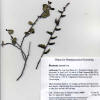|
Rhamnus crocea |
Rhamnus crocea |
|
Rhamnus ilicifolia |
Rhamnus ilicifolia |
|
Trees and Shrubs of Kern County (Jan 2013) Key to Rhamnus
Intricately branched shrubs, often wider than tall, twigs sharply
pointed; Tree-like shrubs, taller than wide, twigs blunt; leaves 1.8–4 cm....... Rhamnus ilicifolia
Rhamnus crocea Nuttall 1838. Spiny redberry, buckthorn. Shrubs, often less than 50 cm high and broad; or up to 2 m, and may even reach 6.7 m in Greenfield, California as reported by Stuart & Sawyer; branches many, reddish on new growth, older gray, stiff and thorny at-tip; leaves evergreen on short stalks (petiole) 1–4 mm, broadly elliptical or round, 1–1.5× longer than wide, 10–15 mm, usually minutely toothed along margins, lateral secondary veins in ~4 pairs, tertiary reticulate veins sometimes evident on upper surface; flowering Mar–Apr; flowers inconspicuous, in tiny clusters up to 6 or solitary on pedicels 1–6 mm, unisexual, green (sepals 4), no petals; fruit a 2-stoned red pyrenarium. A Coast Ranges species of California to Baja California below 3,300 ft. Type from Monterey, CA. Kern Co.: “Rare in Douglas oak woodland in the central Temblor Range (Mesa Ridge, Cedar Canyon),” 3 miles west of Cameron rocks, 853 m (Twisselmann; CCH). This has also included R. ilicifolia as a subspecies; three other collections reported in CCH appear to be R. ilicifolia. Rhamnus ilicifolia Kellogg 1863. Holly-leaf redberry [Rhamnus crocea ssp. ilicifolia C. B. Wolf 1938]. Similar to the preceding species but larger in size, to 4 m or more; young branches reddish orange, leaves larger and more conspicuously spiny along margins, curled downwards across the surface from midway between the midrib and margin, 2–4 cm long on petioles 2–10 mm, with 8 or more lateral veins on each side of the midrib. More widely distributed in California, extending across the deserts to Arizona, also in Oregon. Type from vicinity of Clear Lake, Lake Co., CA. Kern Co.: “Occasional in the chaparral in the mountains and in the central Temblor Range, scarce in the sparse Jeffrey Pine forest on the southern Kern Plateau above 7,000 ft” (Twisselmann). Observed by Spjut as an occasional small tree along the Mill Creek trail growing with Quercus wislizenii and Ceanothus cuneatus, and also elsewhere in the Kern Canyon. When flowers or fruits are not present, the plants may be easily bypassed for interior live oak or canyon live oak; the lateral veins in the oak are not as straight, and the oaks have brown twigs instead of red to reddish orange twigs.
|
|
-Rhamnus_crocea_small.jpg)



